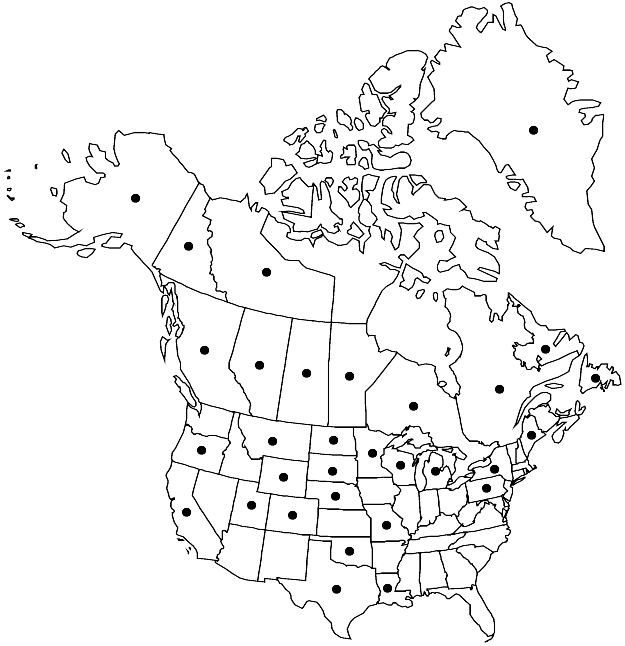Plagiomnium ellipticum
Ann. Bot. Fenn. 8: 367. 1971.
Erect stems 2–5 cm, not dendroid; sterile stems to 12 cm. Leaves green to yellow-green, crisped and contorted when dry, flat when moist, broadly elliptic, ovate, orbicular, or oblong-elliptic, (1–)2–6(–8) mm; base not decurrent or rarely short-decurrent; margins weakly to moderately toothed distally or to 3/4 leaf length, rarely to near base, often entire on sterile stems, teeth blunt, of 1 (or 2) cells; apex broadly rounded, obtuse, or occasionally truncate or retuse, usually narrowly mucronate or cuspidate, cusp bent to side, rarely toothed; costa percurrent or excurrent; medial laminal cells elongate or occasionally ± isodiametric, (30–)50–65(–85) µm, distinctly smaller near margins, often less than 1/2 size, in longitudinal and ± diagonal rows, not to weakly, rarely strongly, collenchymatous, walls pitted, pits sometimes indistinct or absent; marginal cells short-linear or rhomboidal, sometimes linear in larger leaves, in 2–4 rows. Sexual condition dioicous. Seta 1(–3), yellow to reddish brown, 1.8–4.5 cm. Capsule pendent, cylindric or oblong-cylindric, 3–5 mm, neck not distinct; operculum conic-apiculate. Spores 25–30 µm.
Phenology: Capsules mature late spring.
Habitat: Peat or humus in open tundra, bogs, fens, wet meadows and forests, swamps, shores of rivers and lakes, fire-dependent forests/woodlands, cliff/talus
Elevation: low elevations
Distribution

Greenland, Alta., B.C., Man., Nfld. and Labr., N.W.T., Ont., Que., Sask., Yukon, Alaska, Calif., Colo., La., Maine, Mich., Minn., Mo., Mont., Nebr., N.Y., N.Dak., Okla., Oreg., Pa., S.Dak., Tex., Utah, Wis., Wyo., South America, Europe, Asia.
Discussion
Plagiomnium ellipticum often forms wide mats over litter and organic soil in wetland habitats. The species is morphologically variable, especially with respect to leaf margin serration and plant size. Collections from higher latitudes frequently lack marginal teeth. The larger size and the longer, pitted laminal cells of P. ellipticum readily distinguish it from the similar P. rostratum. See the discussion under 2. P. ciliare regarding P. ellipticum.
Selected References
None.